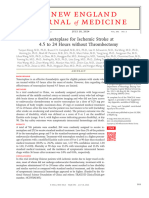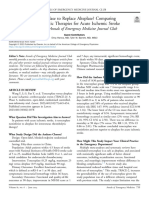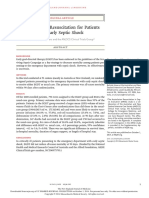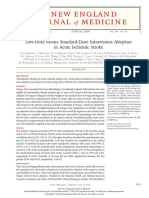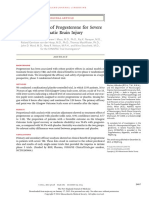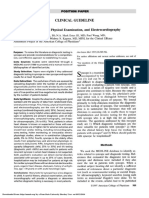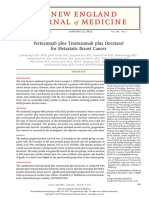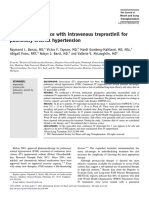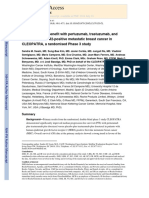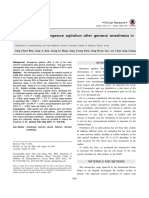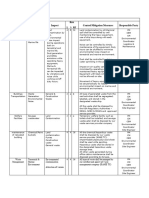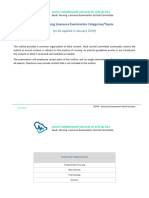Stroke 1 Tiv
Stroke 1 Tiv
Uploaded by
Firdaous TouarsaCopyright:
Available Formats
Stroke 1 Tiv
Stroke 1 Tiv
Uploaded by
Firdaous TouarsaOriginal Title
Copyright
Available Formats
Share this document
Did you find this document useful?
Is this content inappropriate?
Copyright:
Available Formats
Stroke 1 Tiv
Stroke 1 Tiv
Uploaded by
Firdaous TouarsaCopyright:
Available Formats
Articles
Extending thrombolysis to 4·5–9 h and wake-up stroke using
perfusion imaging: a systematic review and meta-analysis of
individual patient data
Bruce C V Campbell*, Henry Ma*, Peter A Ringleb*, Mark W Parsons, Leonid Churilov, Martin Bendszus, Christopher R Levi, Chung Hsu,
Timothy J Kleinig, Marc Fatar, Didier Leys, Carlos Molina, Tissa Wijeratne, Sami Curtze, Helen M Dewey, P Alan Barber, Kenneth S Butcher,
Deidre A De Silva, Christopher F Bladin, Nawaf Yassi, Johannes A R Pfaff, Gagan Sharma, Andrew Bivard, Patricia M Desmond, Stefan Schwab,
Peter D Schellinger, Bernard Yan, Peter J Mitchell, Joaquín Serena, Danilo Toni, Vincent Thijs, Werner Hacke†, Stephen M Davis†,
Geoffrey A Donnan†, on behalf of the EXTEND, ECASS-4, and EPITHET Investigators‡
Summary
Background Stroke thrombolysis with alteplase is currently recommended 0–4·5 h after stroke onset. We aimed to Lancet 2019; 394: 139–47
determine whether perfusion imaging can identify patients with salvageable brain tissue with symptoms 4·5 h or Published Online
more from stroke onset or with symptoms on waking who might benefit from thrombolysis. May 22, 2019
http://dx.doi.org/10.1016/
S0140-6736(19)31053-0
Methods In this systematic review and meta-analysis of individual patient data, we searched PubMed for randomised
See Comment page 97
trials published in English between Jan 1, 2006, and March 1, 2019. We also reviewed the reference list of a previous
*Contributed equally
systematic review of thrombolysis and searched ClinicalTrials.gov for interventional studies of ischaemic stroke.
†Contributed equally
Studies of alteplase versus placebo in patients (aged ≥18 years) with ischaemic stroke treated more than 4·5 h after
‡Investigators listed in the
onset, or with wake-up stroke, who were imaged with perfusion-diffusion MRI or CT perfusion were eligible for
appendix
inclusion. The primary outcome was excellent functional outcome (modified Rankin Scale [mRS] score 0–1) at
Department of Medicine and
3 months, adjusted for baseline age and clinical severity. Safety outcomes were death and symptomatic intracerebral Neurology, Melbourne Brain
haemorrhage. We calculated odds ratios, adjusted for baseline age and National Institutes of Health Stroke Scale score, Centre (Prof B C V Campbell PhD,
using mixed-effects logistic regression models. This study is registered with PROSPERO, number CRD42019128036. Prof M W Parsons PhD,
Prof L Churilov PhD, N Yassi PhD,
G Sharma MCA, A Bivard PhD,
Findings We identified three trials that met eligibility criteria: EXTEND, ECASS4-EXTEND, and EPITHET. Of the Prof B Yan DMedSci,
414 patients included in the three trials, 213 (51%) were assigned to receive alteplase and 201 (49%) were assigned to Prof S M Davis MD,
receive placebo. Overall, 211 patients in the alteplase group and 199 patients in the placebo group had mRS assessment Prof G A Donnan MD)
and Department of Radiology
data at 3 months and thus were included in the analysis of the primary outcome. 76 (36%) of 211 patients in the
(Prof P M Desmond MD,
alteplase group and 58 (29%) of 199 patients in the placebo group had achieved excellent functional outcome at Prof B Yan,
3 months (adjusted odds ratio [OR] 1·86, 95% CI 1·15–2·99, p=0·011). Symptomatic intracerebral haemorrhage was Prof P J Mitchell MMed),
more common in the alteplase group than the placebo group (ten [5%] of 213 patients vs one [<1%] of 201 patients in Royal Melbourne Hospital,
and Florey Institute of
the placebo group; adjusted OR 9·7, 95% CI 1·23–76·55, p=0·031). 29 (14%) of 213 patients in the alteplase group Neuroscience and Mental
and 18 (9%) of 201 patients in the placebo group died (adjusted OR 1·55, 0·81–2·96, p=0·66). Health (Prof B C V Campbell,
Prof H Ma PhD,
Interpretation Patients with ischaemic stroke 4·5–9 h from stroke onset or wake-up stroke with salvageable brain Prof C F Bladin MD, N Yassi,
Prof V Thijs PhD,
tissue who were treated with alteplase achieved better functional outcomes than did patients given placebo. The rate Prof G A Donnan), University
of symptomatic intracerebral haemorrhage was higher with alteplase, but this increase did not negate the overall net of Melbourne, Melbourne, VIC,
benefit of thrombolysis. Australia; Department of
Medicine, School of Clinical
Science (Prof H Ma) and
Funding None. Department of Neurosciences,
Eastern Health and Eastern
Copyright © 2019 Elsevier Ltd. All rights reserved. Health Clinical School
(Prof H M Dewey PhD,
Prof C F Bladin), Monash
Introduction by identifying an MRI pattern suggestive of stroke with an University, Melbourne, VIC,
Current guidelines recommend thrombolysis with intra onset of less than 4·5 h. This method of selection increases Australia; Department of
venous alteplase for acute ischaemic stroke up to 4·5 h the proportion of patients eligible for treatment, but other Neurology (Prof P A Ringleb MD,
from stroke onset on the basis of individual patient data research3 showed that this selection approach only Prof W Hacke MD) and
Department of Neuroradiology
from randomised trials that included patients according identifies around 62% of patients who are within the (Prof M Bendszus MD,
to non-contrast CT brain and clinical criteria.1 These 0–4·5 h time window. Furthermore, this approach J A R Pfaff MD), Ruprecht Karls
criteria exclude a substantial proportion of patients who excludes patients who might have salvageable brain tissue, University Heidelberg,
Heidelberg, Germany;
present more than 4·5 h after stroke onset or who have despite presenting more than 4·5 h after stroke onset.
Department of Medicine
unknown onset (eg, wake-up stroke). The WAKE-UP trial2 An alternative approach is to use CT perfusion or (Prof L Churilov) and
demonstrated the benefit of intravenous thrombolysis perfusion-diffusion MRI to identify patients with poten Department of Neurology
with alteplase in patients with stroke symptoms on waking tially salvageable brain tissue, regardless of time from (Prof V Thijs), Austin Health,
www.thelancet.com Vol 394 July 13, 2019 139
Articles
and Department of Medicine,
Western Hospital, Melbourne Research in context
Medical School
(Prof T Wijeratne MD), Evidence before this study at 3 months was significantly higher in the alteplase group than
University of Melbourne, We did a systematic review of PubMed between Jan 1, 2006, the placebo group. The proportion of patients with functional
Melbourne, VIC, Australia; and March 1, 2019, for randomised controlled trials published in improvement (≥1 point reduction in modified Rankin Scale
Department of Neurology,
Priority Research Centre for
English using the search terms “stroke” AND either “randomized” score) at 3 months was also significantly higher in the alteplase
Brain and Mental Health OR “randomised” AND either “thrombolysis” OR “alteplase” OR group than the placebo group. Although a higher proportion of
Research, John Hunter Hospital, “tPA”. In the EXTEND trial, patients randomly assigned to patients in the alteplase group had symptomatic intracerebral
University of Newcastle, alteplase after automated CT or MRI perfusion imaging were haemorrhage than the placebo group, no significant difference
Newcastle, NSW, Australia
(Prof C R Levi MBBS); Graduate
found to have improvement in excellent functional outcome in mortality was observed between the groups. Patients with a
Institute of Clinical Medical compared with placebo; however, the strength and precision of perfusion imaging mismatch (indicating salvageable brain
Science, China Medical findings were limited by the modest sample size (n=225). tissue) detected with automated software in core laboratory
University, Taichung, Taiwan The ECASS4-EXTEND trial randomly assigned 119 patients after analysis had significant benefit from alteplase, whereas those
(Prof C Hsu PhD); Department of
Neurology, Royal Adelaide
visual assessment of perfusion-diffusion MRI, and found no without perfusion mismatch detected by automated software
Hospital, Adelaide, SA, statistically significant benefits of alteplase. EPITHET was a did not, although this comparison was underpowered and
Australia (T J Kleinig PhD); phase 2 randomised trial of alteplase 3–6 h after stroke onset formal statistical interaction was not demonstrated.
Department of Neurology,
using perfusion-diffusion MRI, in which 70 patients were treated
Faculty of Medicine Mannheim, Implications of all the available evidence
University of Heidelberg, within the 4·5–6 h time window. Although the overall results of
Patients with ischaemic stroke 4·5–9 h after stroke onset or
Mannheim, Germany the trial were neutral, in patients treated 4·5–6 h after stroke
with wake-up stroke with evidence of salvageable brain tissue
(Prof M Fatar MD); Department onset, thrombolysis reduced relative infarct growth and
of Neurology, Hospital CHU using CT perfusion or perfusion-diffusion MRI who were given
increased the rate of reperfusion. Effective reperfusion was
Lille, Lille, France intravenous alteplase have improved functional outcomes
(Prof D Leys MD); Department associated with good neurological and functional outcome.
compared with those given placebo. Patients given alteplase
of Neurology, Hospital
Vall d´Hebron, University of
Added value of this study had an increased risk of symptomatic intracerebral
Barcelona, Barcelona, Spain This systematic review and meta-analysis of individual patient haemorrhage, consistent with the findings from previous trials
(Prof C Molina MD); Department data quantifies the benefits and risks of intravenous alteplase of alteplase for stroke, but this increased risk does not offset
of Neurology, Western Health, for patients with ischaemic stroke beyond 4·5 h from when the net benefit of thrombolysis. The benefit to risk ratio seems
Sunshine Hospital, Melbourne,
VIC, Australia (Prof T Wijeratne);
they were last known to be well. The proportion of patients to be larger in patients who meet automated perfusion
Department of Neurology, with excellent functional outcome (return to all usual activities) mismatch criteria.
Helsinki University Hospital,
Helsinki, Finland (S Curtze PhD);
Department of Neurology, stroke onset. Reperfusion beyond 4·5 h after stroke onset had pretreatment imaging with CT perfusion or
Auckland City Hospital, is associated with favourable clinical outcomes in patients perfusion-diffusion MRI were eligible for inclusion.
University of Auckland, with perfusion mismatch.4–7 Patient selection on the basis Full eligibility criteria for all trials are described in
Auckland, New Zealand
(Prof P A Barber PhD); Prince of
of perfusion mismatch to identify treatment-responsive the appendix. We also reviewed the reference list of a
Wales Clinical School, patients with salvageable brain tissue who have presented previous systematic review of thrombolysis1 and searched
University of New South Wales, more than 4·5 h after stroke onset has been established for ClinicalTrials.gov for interventional studies of ischaemic
Sydney, NSW, Australia endovascular thrombectomy in patients with large vessel stroke using the keywords thrombolysis and alteplase.
(Prof K S Butcher PhD); Division
of Neurology, University of
occlusion 6–24 h after the time they were last known to be Patients with available data on age, pretreatment National
Alberta, Edmonton, AB, Canada well.8–10 Intravenous thrombolysis could potentially treat a Institutes of Health Stroke Scale (NIHSS) score, and
(Prof K S Butcher); Department broader range of patients. modified Rankin Scale (mRS) score at 3 months were
of Neurology, Singapore We did a meta-analysis of individual patient data to test eligible for inclusion in the meta-analysis. Two reviewers
General Hospital, National
Neuroscience Institute,
the hypothesis that intravenous alteplase improves (BCVC and NY) independently assessed articles for
Singapore (D A De Silva FRCP); functional outcomes compared with placebo in patients inclusion.
Department of Neurology, with ischaemic stroke 4·5–9 h after onset or wake-up The management committees of all included trials
University of stroke who were imaged with CT perfusion or perfusion- agreed to share individual patient-level data for the
Erlangen-Nuremberg, Erlangen,
Germany (Prof S Schwab MD);
diffusion MRI. purposes of this meta-analysis. Ethical approval was
Department of Neurology and obtained at all participating sites for all included trials,
Neurogeriatry, Johannes Methods and informed consent was obtained from all participants
Wesling Medical Centre Search strategy and selection criteria or their legal representative. The protocol for this study
Minden, University Hospital of
Ruhr-University Bochum,
We did a systematic search of PubMed for randomised was prespecified and followed PRISMA guidelines
Bochum, Germany controlled trials published in English between Jan 1, 2006, (appendix).
(Prof P D Schellinger MD); and March 1, 2019, using the search terms “stroke”
Department of Neurology,
AND either “randomized” OR “randomised” AND either Data analysis
Girona University Hospital,
Biomedical Research Institute “thrombolysis” OR “alteplase” OR “tPA”. Trials of A statistician (LC) merged the databases of the included
of Girona, Girona, Spain intravenous alteplase versus placebo in adults (aged studies on the basis of data fields prespecified in the
(Prof J Serena PhD); and ≥18 years) with hemispheric ischaemic stroke more protocol. We extracted data on treatment, age, sex,
Department of Neurology,
than 4·5 h after stroke onset or wake-up stroke who pretreatment NIHSS score, geographical location, time
140 www.thelancet.com Vol 394 July 13, 2019
Articles
post stroke onset or after wake-up stroke, atrial fibril For analysis of the prespecified subgroup with Sapienza University of Roma,
lation, hypertension, diabetes, smoking status, NIHSS perfusion mismatch determined by automated Rome, Italy (Prof D Toni MD)
score at 72 h, mRS at 3 months, and symptomatic processing software, CT perfusion and perfusion- Correspondence to:
Prof Geoffrey A Donnan,
intracerebral haemorrhage. diffusion MRI imaging data for individual patients were
Department of Medicine and
For this meta-analysis, the prespecified primary outcome uniformly reprocessed using RAPID (version 4.6; Neurology, Melbourne Brain
was the proportion of patients with excellent functional iSchemaView, Menlo Park, CA, USA) as described Centre, Royal Melbourne
outcome (mRS score 0–1 [return to all usual activities]) previously.8,9 Although all patients in the EXTEND Hospital, University of
Melbourne, Melbourne,
at 3 months, adjusted for pretreatment clinical severity trial12,13 were judged to meet automated mismatch criteria VIC 3050, Australia
(NIHSS score) and age. Secondary outcomes were by the enrolment site, central analysis of perfusion geoffrey.donnan@unimelb.
functional improve ment (≥1 point reduction in mRS mismatch was done to exclude imaging artefacts and to edu.au
score [ordinal shift analysis]), with mRS categories 5 account for software evolution over the 8 years of trial See Online for appendix
and 6 merged, at 3 months, func tional independence recruitment. All automated output was visually verified
(mRS score 0–2) at 3 months, and early neurological and artefacts removed by a stroke neurologist with
improvement (reduction of ≥8 points on NIHSS or extensive neuroimaging analysis experience, masked to
reaching NIHSS score 0–1) at 72 h. All secondary outcomes treatment allocation and all other imaging and clinical
were adjusted for pretreat ment NIHSS score and age. information. For CT perfusion, irreversibly injured
Safety outcomes were symptomatic intracerebral haemor ischaemic core was defined as a relative cerebral blood
rhage defined as parenchymal haemorrhage type 2 (blood flow of less than 30% of normal brain blood flow.14 For
clot occupying >30% of the infarcted territory with diffusion MRI, ischaemic core was defined as an
substantial mass effect) within 36 h of treatment, combined apparent diffusion coefficient of less than 620 μm²/s.15
with neurological deterioration of 4 or more NIHSS points,
or death.11 Death due to any cause at 3 months was adjusted Placebo Alteplase
for age and pretreatment NIHSS score. (n=201) (n=213)
A full description of the analyses is provided in Age, years 72·0 (12·3) 73·2 (12·2)
the prespecified statistical analysis plan (appendix). Sex
Statistical analysis was done using Stata (version 15). Men 116 (58%) 119 (56%)
Qualitative assessment of between trial differences Women 85 (42%) 94 (44%)
including patient eligibility and assessment of bias are NIHSS score 10 (6–16) 12 (7–17)
shown in the appendix. Previously diagnosed atrial fibrillation 63 (31%) 79 (37%)
Our meta-analysis followed a one-stage approach. To History of hypertension 134 (67%) 159 (75%)
account for between-trial variance we used mixed-effects History of diabetes 41 (20%) 49 (23%)
logistic regression models with trial and trial-by-treatment History of smoking 62/165 (38%) 58/179 (32%)
interaction terms incorporated as random effects in all Geographical region
models. We analysed the primary outcome and other Australia or New Zealand 110 (55%) 121 (57%)
dichotomous secondary and safety outcomes using Europe 67 (33%) 69 (32%)
mixed-effects logistic regression models, adjusted for
Asia 24 (12%) 23 (11%)
baseline age and NIHSS score, to estimate adjusted odds
Time from stroke onset to randomisation
ratios (ORs) and 95% CIs. Functional improvement was
>4·5–6·0 h 49 (24%) 58 (27%)
analysed using mixed-effects ordinal logistic regression
>6·0–9·0 h 48 (24%) 50 (24%)
(with mRS 5 and 6 categories merged), adjusted for
Wake-up stroke 104 (52%) 105 (49%)
baseline age and NIHSS score. We did preplanned
Imaged with CT perfusion 96 (48%) 100 (47%)
subgroup analyses to assess the effects of age (≤75 vs
Imaged with perfusion-diffusion 105 (52%) 113 (53%)
>75 years and ≤80 vs >80 years), baseline stroke severity MRI
(NIHSS score ≤10 vs NIHSS score >10), time to treatment Time from stroke onset* to initiation 413 (353–480) 417 (346–485)
(>4·5–6·0 h, >6·0–9·0 h, or wake-up stroke), geographical of intravenous therapy, min
region (Australia and New Zealand, Europe, or Asia), and Time from last known to be well to 487 (360–655) 471 (355–649)
presence of any large vessel occlusion. Large vessel initiation of intravenous therapy, min
occlusion was defined as occlusion of the internal carotid Large vessel occlusion 122/198 (62%) 124/205 (60%)
artery or middle cerebral artery (M1 or proximal M2), Ischaemic core volume† at initial 8·1 (0–20·4) 8·0 (0–25·3)
based on central imaging review, to identify patients imaging
who would be eligible for endovascular thrombectomy Perfusion lesion volume‡ at initial 64·3 63·9
imaging (33·2–97·0) (27·9–117·2)
according to current clinical practice. Analyses were
repeated in the prespecified subgroup of patients who Data are mean (SD), n (%), median (IQR), or n/N (%). NIHSS=National Institutes of
Health Stroke Scale. *Onset time measured as the midpoint of falling asleep and
met automated perfusion mismatch criteria. For all waking with stroke symptoms for patients with wake-up stroke. †Relative
subgroup analyses, treatment-by-subgroup interactions cerebral blood flow less than 30% of normal blood flow. ‡Time to maximum >6 s.
were tested by including multiplicative interaction terms
Table 1: Baseline characteristics of all patients
in respective regression models.
www.thelancet.com Vol 394 July 13, 2019 141
Articles
mRS score
writing of this report. The corresponding author had
0 1 2 3 4 5 6 full access to all the data in the study and had final
responsibility for the decision to submit for publication.
Placebo 10% 20% 15% 15% 21% 12% 9%
(n=199) (n=19) (n=39) (n=29) (n=30) (n=41) (n=23) (n=18)
Results
Our search strategy identified three trials that met the
Alteplase 15% 21% 13% 15% 14% 9% 14%
eligibility criteria: EXTEND,12,13 ECASS4-EXTEND,17,18 and
(n=211) (n=31) (n=45) (n=27) (n=31) (n=29) (n=19) (n=29) EPITHET.5 The three included trials compared intra
venous alteplase with placebo (0·9 mg/kg, maximum
0 10 20 30 40 50 60 70 80 90 100
90 mg delivered as a 10% bolus and 90% infusion over
Patients (%)
1 h). The phase 3 EXTEND randomised controlled trial12,13
Figure 1: mRS scores at 3 months for all patients compared alteplase with placebo in patients 4·5–9·0 h
mRS=modified Rankin Scale. from stroke onset and patients with wake-up stroke using
automated CT perfusion or MRI perfusion-diffusion
mismatch selection. EXTEND recruited patients from
Placebo Alteplase Odds ratio* p value
(n=201) (n=213) (95% CI) Australasia, Taiwan, and Finland. The trial was terminated
early due to loss of equipoise after the results of the
Primary outcome
WAKE-UP trial,2 but showed that higher proportions of
Excellent functional outcome 58/199 (29%) 76/211 (36%) 1·86 (1·15–2·99) 0·01
(mRS score 0–1) at 3 months patients achieved excellent functional outcome with
Secondary outcomes alteplase compared with placebo administered 4·5–9 h
Functional improvement in mRS NA NA 1·60 (1·12–2·27) 0·009 after onset or within 9 h of the midpoint of falling asleep
score at 3 months† and waking with stroke symptoms. The European
Functional independence 87/199 (44%) 103/211 (49%) 1·74 (1·08–2·81) 0·02 ECASS4-EXTEND trial17,18 used the same clinical eligibility
(mRS score 0–2) at 3 months criteria as EXTEND but used visual assessment of MRI
Early neurological improvement 31/197 (16%) 58/206 (28%) 2·54 (1·51–4·27) <0·0001 perfusion-diffusion imaging. ECASS4-EXTEND was
at 72 h‡
terminated early due to reduced recruitment following
Safety outcomes
the positive trials8,9 of thrombectomy in the 6–24 h
Death at 3 months 18/201 (9%) 29/213 (14%) 1·55 (0·81–2·97) 0·19 treatment window. The trial demonstrated no significant
Symptomatic intracerebral 1/201 (<1%) 10/213 (5%) 9·70 (1·23–76·55) 0·03 benefit in the alteplase group compared with placebo.
haemorrhage§
The phase 2 EPITHET trial4 randomly assigned patients
Data are n/N (%). mRS=modified Rankin Scale. NIHSS=National Institutes of Health Stroke Scale. NA=not applicable. to alteplase or placebo within 3–6 h of stroke onset after
*Adjusted for baseline age and NIHSS. †Reduction of ≥1 point in mRS score (with mRS categories 5 and 6 merged),
analysed using ordinal logistic regression. ‡Reduction of ≥8 points on NIHSS or reaching NIHSS score 0–1 at 72 h. perfusion-diffusion MRI, which was processed offline to
§Within 36h of treatment. determine the presence of perfusion mismatch. Only
Table 2: Study outcomes in all patients
patients treated 4·5–6·0 h after stroke onset in EPITHET
were included in our meta-analysis. No significant
differences in the primary outcome of geometric mean
The volume of critically hypoperfused tissue (the infarct growth were identified between treatment groups.
penumbra and core combined) was estimated using CT However, alteplase increased reperfusion, which, in turn
perfusion or perfusion MRI with a time to maximum was associated with reduced infarct growth and improved
threshold of more than 6 s.16 Time to maximum relates clinical outcomes.19
to the time delay in tissue enhancement after a bolus Of the 414 patients included in the three trials (mean
of intravenous contrast is given. Mismatch volume age 73 years [SD 12·2]), 213 (51%) patients were assigned
(ie, estimated penumbral volume) was defined as to receive alteplase and 201 (49%) to receive placebo.
critically hypoperfused tissue volume minus ischaemic Baseline characteristics were largely balanced between
core volume. Mismatch ratio was defined as critically the two groups (table 1); however, initial stroke severity
hypoperfused tissue volume divided by ischaemic core was non-significantly worse in the alteplase group than
volume. Patients with a mismatch ratio greater than 1·2, the placebo group (median NIHSS score 12 [IQR 7–17] vs
a mismatch volume greater than 10 mL, and an 10 [6–16]). Most patients were recruited from Australia
ischaemic core volume less than 70 mL were considered or New Zealand, followed by Europe and Asia. Approxi
to have perfusion mismatch. This study is registered mately half of all included patients had wake-up stroke
with PROSPERO, number CRD42019128036. (n=105 in the alteplase group; n=104 in the placebo
group). The median time from when the patient was last
Role of the funding source known to be well to treatment in patients with wake-up
There was no funding source for this study. The funders stroke was 10 h 42 min (IQR 8 h 40 min–12 h 20 min).
of the component EXTEND, ECASS4-EXTEND, and Overall, of the 403 patients with assessable angiographic
EPITHET studies had no role in study design, data imaging, 246 (61%) had large vessel occlusion that would
collection, data analysis, data interpretation, or the potentially be amenable to endovascular thrombectomy.
142 www.thelancet.com Vol 394 July 13, 2019
Articles
A All patients B Patients with perfusion mismatch
n Odds ratio (95% CI) pinteraction n Odds ratio (95% CI) pinteraction
Study Study
EXTEND 225 1·88 (0·99–3·59)* EXTEND 204 1·87 (0·96–3·64)
ECASS-4 116 1·68 (0·67–4·22) 0·60 ECASS-4 65 1·91 (0·50–7·32) 0·41
EPITHET 69 2·28 (0·71–7·35) EPITHET 34 21·76 (1·27–373·69)
Age (years) Age (years)
≤75 199 1·81 (0·95–3·43) ≤75 146 1·71 (0·83–3·52)
0·99 0·69
>75 211 1·90 (0·93–3·89) >75 157 2·63 (1·06–6·55)
Age (years) Age (years)
≤80 270 2·00 (1·14–3·49) ≤80 200 2·00 (1·04–3·82)
0·58 0·91
>80 140 1·54 (0·62–3·83) >80 103 2·27 (0·71–7·21)
NIHSS NIHSS
≤10 175 2·92 (1·53–5·58) ≤10 121 2·58 (1·20–5·55)
0·03 0·15
>10 235 1·01 (0·49–2·06) >10 182 1·43 (0·62–3·30)
Time strata (h) Time strata (h)
4·5–6 104 2·19 (0·82–5·85) 4·5–6 63 6·71 (1·24–36·33)
6–9 97 2·27 (0·83–6·24) 0·87 6–9 74 1·14 (0·37–3·52) 0·38
Wake-up stroke 209 1·56 (0·81–3·02) Wake-up stroke 166 2·18 (1·05–4·54)
Region Region
Australia or New Zealand 230 1·47 (0·78–2·77) Australia or New Zealand 180 1·53 (0·75–3·14)
Asia 47 4·21 (0·83–21·51) 0·39 Asia 41 4·32 (0·76–24·52) 0·30
Europe 133 2·30 (0·99–5·33) Europe 82 3·39 (1·06–10·85)
Large vessel occlusion Large vessel occlusion
155 1·93 (0·96–3·89) 83 1·97 (0·78–4·99)
No 0·66 No 0·99
244 1·74 (0·89–3·38) 219 2·13 (1·04–4·35)
Yes Yes
Overall 410 1·86 (1·15–2·99) Overall 303 2·06 (1·17–3·62)
0·25 0·5 1 2 4 8 16 0·125 0·5 1 2 4 8 16 64 256
Favours placebo Favours alteplase Favours placebo Favours alteplase
Figure 2: Subgroup analyses
Forest plots for the primary outcome of excellent functional outcome (modified Rankin Scale 0–1) in all patients (A) and patients with automated perfusion mismatch (B). Proportion of patients by
treatment group for each subgroup are detailed in the appendix. NIHSS=National Institutes of Health Stroke Scale score. *Prespecified analysis of primary outcome for EXTEND trial used modified
Poisson regression (adjusted risk ratio [for modified Rankin Scale score 0–1] 1·44, 95%CI 1·01–2·06; p=0·04).
However, 97% of patients (403 of 414) were recruited (table 2). Prespecified subgroup analyses for the primary
before guideline changes made in February, 2018, outcome are shown in figure 2 and subgroup analyses
recommended thrombectomy in the 6–24 h window and for additional outcomes are shown in the appendix.
consideration of thrombectomy was an exclusion The number of patients with symptomatic intracerebral
criterion in the three trials included. The median haemorrhage was significantly higher in the alteplase
perfusion mismatch was 47 mL (IQR 17–85) with a group than the placebo group (ten [5%] of 213 patients vs
median volume of critical hypoperfusion of 64 mL one [<1%] of 201 patients, adjusted OR 9·7, 95% CI
(30–109) and relatively small core of median volume 1·23–76·55, p=0·031). This included one patient with
8 mL (0–22). haemorrhagic transformation on the pretreatment CT
Of the 414 patients included in the three trials, scan (a protocol violation). However, no significant dif
211 patients in the alteplase group and 199 patients in the ferences were identified in mortality between the alteplase
placebo group had mRS data available at 3 months and and placebo groups (29 [14%] of 213 patients vs 18 [9%] of
thus were included in the analysis of the primary 201 patients, adjusted OR 1·55, 95% CI 0·81–2·96,
outcome. 76 (36%) of 211 patients in the alteplase group p=0·19; table 2). All deaths are described in the appendix.
achieved the primary outcome of excellent functional Four deaths occurred in the first week after alteplase
outcome (mRS score 0–1) at 3 months compared with treatment due to symptomatic intracerebral haemorrhage
58 (29%) of 199 patients in the placebo group (adjusted related to treatment. One death in the alteplase group due
odds ratio [OR] 1·86, 95% CI 1·15–2·99, p=0·011; to remote intracerebral haemorrhage that occurred on
figure 1, table 2). The proportion of patients achieving day 4 was attributed to heparin and warfarin admin
functional improvement and functional independence at istration. An additional death in the alteplase group
3 months, and the proportion of patients with early occurred on day 77 due to pneumonia in a patient who
neurological improvement at 72 h was significantly had symptomatic intracerebral haemorrhage on day 1.
higher in the alteplase group than the placebo group 42 (90%) of 47 deaths were unrelated to treatment. No
www.thelancet.com Vol 394 July 13, 2019 143
Articles
automated perfusion mismatch who had available mRS
Placebo (n=152) Alteplase (n=152)
scores at 3 months, the proportion of patients who
Age, years 72·1 (12·3) 73·2 (13·1) achieved excellent functional outcome was higher in the
Sex alteplase group than the placebo group (55 [36%] of
Men 91 (60%) 86 (57%) 152 patients vs 39 [26%] of 151 patients; adjusted OR 2·06,
Women 61 (40%) 66 (43%) 95% CI 1·17–3·62, p=0·012; figure 3, table 4), and the
NIHSS score 11 (7–17) 12 (7–17) point estimate of the effect size was larger in this
Previously diagnosed atrial 53 (35%) 60 (40%) subgroup analysis than the intention-to-treat analysis.
fibrillation
Among patients without mismatch, no significant
History of hypertension 95 (63%) 113 (74%)
differences were observed in the proportion of patients
History of diabetes 28 (19%) 37 (24%) who achieved excellent functional outcome between
History of smoking 52/119 (44%) 40/121 (33%) the alteplase and placebo groups (adjusted OR 1·22,
Geographical region 95% CI 0·48–3·10, p=0·68; treatment by mismatch status
Australia or New Zealand 91 (60%) 89 (59%) interaction p=0·43). Similarly, among patients with
Europe 40 (26%) 43 (28%) mismatch, significant improvements in all secondary
Asia 21 (14%) 20 (13%) outcomes were observed in the alteplase group (table 4),
Stroke onset to randomisation time whereas no significant differences were identified
>4·5–6·0 h 31 (20%) 33 (22%) between the treatment groups among patients without
>6·0–9·0 h 37 (24%) 37 (24%) mismatch (appendix). Safety outcomes in patients with
Wake-up stroke 84 (55%) 82 (54%) perfusion mismatch were similar to those for all patients.
Imaged with CT perfusion 90 (59%) 89 (59%) Among patients with perfusion mismatch, the proportion
Imaged with 62 (41%) 63 (41%) of patients with an mRS score of 5 or 6 in the alteplase
perfusion-diffusion MRI and placebo groups was similar (34 [23%] of 152 patients
Time from stroke onset* to 422 (355–492) 425 (351–490) vs 36 [23%] of 151 patients; adjusted OR 0·83, 95% CI
initiation of intravenous
therapy, min
0·46–1·53, p=0·557).
Time from last known to be 503 (374–657) 489 (374–670)
well to initiation of Discussion
intravenous therapy, min This meta-analysis of pooled individual patient-level data
Large vessel occlusion 113/152 (74%) 107/151 (71%) has shown that thrombolysis with intravenous alteplase
Ischaemic core volume† at 8·9 (0–20·0) 6·2 (0–22·3) in patients with acute ischaemic stroke 4·5–9 h after
initial imaging stroke onset or wake-up stroke, who were imaged with
Perfusion lesion volume‡ at 75·1 (47·0–104·9) 74·0 (40·2–117·2) CT perfusion or perfusion-diffusion MRI, improves
initial imaging
functional outcomes compared with placebo. The
Data are mean (SD), n (%), median (IQR), or n/N (%). NIHSS=National Institutes of frequency of symptomatic intracerebral haemorrhage
Health Stroke Scale. *Onset time measured as the midpoint of falling asleep and
waking with stroke symptoms for patients with wake-up stroke. †Relative was around 4% higher in the alteplase group than the
cerebral blood flow less than 30% of normal blood flow. ‡Time to maximum >6 s. placebo group, which is consistent with the results of
Table 3: Baseline characteristics of patients with automated perfusion
previous trials1 of alteplase 0–4·5 h after stroke. However,
mismatch this did not negate the benefit of alteplase in ordinal
analysis of the mRS, which accounts for transitions
across the disability spectrum. Mortality was not
significant differences were identified in the proportion significantly increased with alteplase and the proportion
of patients with combined mRS scores of 5 or 6 (death of patients who had an mRS score of 5 or 6 (ie, dead or
and requirement for constant nursing care): 48 (23%) of requiring nursing home care) did not differ significantly
211 patients in the alteplase group versus 41 (21%) of between groups. Although no statistically significant
199 patients in the placebo group (adjusted OR 1·03, interaction was identified between mismatch status and
95% CI 0·62–1·74, p=0·897). treatment effect, the benefit of alteplase in terms of
Central adjudication of perfusion mismatch status functional outcome and independence, and neurological
using automated RAPID software was possible in improvement was significant in patients who met
405 patients (raw imaging data were not available for automated perfusion mismatch criteria, but did not
six patients in the alteplase group and three patients in reach statistical significance in patients without perfusion
the placebo group). After central adjudication of perfusion mismatch.
mismatch status in these 405 patients, 304 patients had The benefits of alteplase observed in this analysis
perfusion mismatch (152 [73%] of 207 patients in the compare favourably with those reported within 4·5 h of
alteplase group and 152 [77%] of 198 patients in the stroke onset. The adjusted OR for achieving an mRS score
placebo group). Baseline characteristics of patients with 0–1 among all patients was 1·86 (95% CI 1·15–2·99) and
automated perfusion mismatch were balanced between 2·06 (1·17–3·62) for patients with automated perfusion
the groups (table 3). Among the 303 patients with mismatch, compared with an adjusted OR of 1·75
144 www.thelancet.com Vol 394 July 13, 2019
Articles
(1·35–2·27) for alteplase administered 0–3 h from stroke
A
onset and 1·26 (1·05–1·51) for alteplase administered mRS score
3–4·5 h from stroke onset, as reported previously.1 The 0 1 2 3 4 5 6
absolute increase in the proportion of patients who
achieved excellent functional outcome in this pooled Placebo 10% 16% 14% 15% 21% 13% 11%
(n=151) (n=15) (n=24) (n=21) (n=23) (n=32) (n=20) (n=16)
analysis was 7% higher in the alteplase group than
the placebo group (10% in patients with perfusion mis
match). However, these unadjusted proportions are likely Alteplase 14% 22% 14% 13% 13% 9% 13%
to underestimate the true benefit since there was a trend (n=152) (n=21) (n=34) (n=22) (n=21) (n=20) (n=14) (n=20)
towards older age and greater clinical severity in the
patients given alteplase. By comparison, alteplase admin
istered 0–3 h after stroke onset improved excellent B
4% (n=2)
functional outcome by 9·8%. This reduced to 5·2% when Placebo 9% 33% 16% 16% 18%
administered at 3–4·5 h.1 In the WAKE-UP trial,2 which (n=45) (n=4) (n=15) (n=7) (n=7) (n=8)
administered alteplase based on MRI evidence of onset at 4% (n=2)
less than 4·5 h, the unadjusted improvement in excellent
outcome was 11·5% and the adjusted OR was 1·61 Alteplase 19% 17% 9% 15% 15% 8% 17%
(n=53) (n=10) (n=9) (n=5) (n=8) (n=8) (n=4) (n=9)
(95% CI 1·09–2·36). The treatment effect with alteplase
was numerically lower than that observed with 0 10 20 30 40 50 60 70 80 90 100
endovascular thrombectomy (18% difference in mRS Patients (%)
score 0–1).8,9 This difference might reflect the more
Figure 3: mRS score at 3 months by perfusion mismatch subgroup
effective reperfusion achieved with endovascular throm mRS score for patients with automated perfusion mismatch (A), and patients without automated perfusion
bectomy. The mismatch volume in this analysis was mismatch (B). Among patients with mismatch, one patient in the placebo group was excluded because they did not
also approximately half that reported in previous have mRS assessment at 3 months. Among patients without mismatch, one patient in the placebo group and
thrombectomy trials,8,9 which might have reduced the two patients in the alteplase group were excluded because they did not have mRS assessment at 3 months. Imaging
data were not available for six patients in the alteplase group and three patients in the placebo group; thus perfusion
potential benefit of reperfusion. For patients with wake- mismatch status could not be determined. mRS=modified Rankin Scale.
up stroke, both EXTEND and ECASS4-EXTEND diverged
from the standard definition of stroke onset (ie, time
Placebo Alteplase Odds ratio p value
the patient was last known to be well). The treatment (n=152) (n=152) (95% CI)*
window for patients with wake-up stroke in EXTEND and
Primary outcome
ECASS4-EXTEND was 9 h after the midpoint of the time
Excellent outcome (mRS score 0–1) 39/151 (26%) 55/152 (36%) 2·06 (1·17–3·62) 0·012
they fell asleep to the time they woke with symptoms.
at 3 months
Using the standard definition of onset this led to patients
Secondary outcomes
being treated up to almost 16 h after the time the patient
Functional improvement in mRS NA NA 1·68 (1·11–2·53) 0·014
was last known to be well. score at 3 months†
The risks of alteplase in the extended time window were Functional independence 60/151 (40%) 77/152 (51%) 2·22 (1·25–3·94) 0·006
similar to those for the standard 0–4·5 h treatment (mRS score 0–2) at 3 months
window. Symptomatic intracranial haemorrhage occurred Early neurological improvement at 26/152 (17%) 44/148 (30%) 2·26 (1·26–4·03) 0·006
in 4·7% of patients compared with 3·4% in a meta-analysis 72 h‡
of 0–4·5 h alteplase trials20 using the same definition. Fatal Safety outcomes
intracerebral haemorrhage occurred in 2·3% of patients Death at 3 months 16/152 (11%) 20/152 (13%) 1·28 (0·60–2·73) 0·52
in this analysis compared with 2·6% in the 0–4·5 h data.1 Symptomatic intracerebral 1/152 (1%) 7/152 (5%) 7·29 (0·88–60·18) 0·07
Automated perfusion mismatch selection did not seem haemorrhage§
to alter the risk of symptomatic intracerebral haemorrhage Data are n/N (%). mRS=modified Rankin Scale. NIHSS=National Institutes of Health Stroke Scale. NA=not applicable.
One patient in the placebo group did not have available mRS data at 3 months and thus was excluded from the analysis
in the alteplase group compared with all patients. However,
of the primary outcome and selected secondary outcomes. *Adjusted for baseline age and NIHSS. †Reduction of
detailed analysis of the cause and timing of death indicated ≥1 point in mRS score (with mRS categories 5 and 6 merged), analysed using ordinal logistic regression. ‡Reduction of
that 42 (90%) of 47 deaths were not related to alteplase ≥8 points on NIHSS or reaching NIHSS score 0–1 at 72 h. §Within 36 h of treatment.
(appendix). No significant difference in the proportion Table 4: Study outcomes in patients with automated perfusion mismatch (n=304)
of patients with an mRS score of 5 or 6 (death and
requirement for constant nursing care) was identified
between treatment groups. The absence of mortality demonstrated statistically significant improvement in
benefit with thrombolysis in this analysis is consistent excellent functional outcome (mRS score 0–1) and
with trials of alteplase 0–4·5 h after stroke onset.1 functional independence (mRS score 0–2) but did not
The three trials5,13,18 included in this meta-analysis reach significance for the ordinal functional improvement
demonstrated consistent treatment effects with mini outcome. The magnitude of benefit using the ordinal
mal heterogeneity. This pooled analysis substantially outcome indicates that the benefit of increased excellent
strengthens the results of the EXTEND trial, which outcome is not offset by an increase in poor outcomes,
www.thelancet.com Vol 394 July 13, 2019 145
Articles
despite the increase in symptomatic intracerebral immediate access to endovascular throm bectomy, this
haemorrhage. meta-analysis supports the use of intravenous thrombolysis
Automated imaging selection was successfully used in in patients with perfusion mismatch 4·5–9 h from stroke
previous trials8,9 of extended time windows for endo onset or with symptoms on waking, regardless of the
vascular thrombectomy and in EXTEND.12 This provides presence of large vessel occlusion. For patients without
objective thresholds to standardise imaging assessment. large vessel occlusion, our data expand the proportion of
Applying automated processing in this analysis excluded patients with ischaemic stroke who can receive reperfusion
around 24% of patients, mostly with small perfusion therapies.
lesions with less than 10 mL mismatch. The analysis In conclusion, alteplase improved functional outcomes
was underpowered to detect a statistical interaction in patients with acute ischaemic stroke in an extended
between mismatch status and treatment effect. However, time window when perfusion imaging was favourable.
the magnitude of difference in point estimates suggests The benefit was evident across a range of patient
that the effect is driven by patients meeting perfusion subgroups and geographical locations. The risk of symp
mismatch criteria. tomatic intracerebral haemorrhage was consistent with
Limitations of this study include the early termination of that observed in previous trials of stroke thrombolysis
two of the three included trials (EXTEND and ECASS4- with alteplase in the 0–4·5 h treatment window and did
EXTEND), which limited the overall sample size. In both not offset the overall benefits in functional outcome. This
trials, however, termination was due to external factors, pooled analysis provides strong evidence in support of
which reduces the potential bias. The requirement for thrombolysis for patients with favourable perfusion
perfusion imaging might impede implementation in imaging 4·5–9 h after stroke, including patients with
some regions. However, the CT perfusion imaging wake-up stroke.
selection used in the majority of patients included in the Contributors
EXTEND trial is more generally available than urgent BCVC, HM, PAR, LC, WH, SMD, and GAD developed the study protocol
MRI. Automated software is commercially available but and drafted the manuscript. Imaging analysis was done by BCVC, GS,
AB, and NY. All authors collected data and edited the manuscript.
can be costly in resource-restricted environ ments. Our
results suggest that automated assessment of mismatch Declaration of interests
PAR reports grants from Boehringer Ingelheim during the conduct of
is more reliable for the identification of treatment the study, and personal fees from Boehringer Ingelheim, Bayer,
responders than visual assess ment, consistent with and Pfizer, outside the submitted work. MWP reports reimbursement
previous studies.21,22 Physician oversight is, however, still for travel expenses from Boehringer Ingelheim, and collaborated with
required for the interpretation of automated output. An Apollo Medical Imaging for research purposes, outside the submitted
work. MB reports personal fees from Boehringer Ingelheim, Merck,
MRI-based selection approach would allow either the Bayer, Teva, BBraun, Springer, Vascular Dynamics, and Grifols; grants
diffusion-FLAIR mismatch approach, as used in the and personal fees from Novartis, Codman, and Guerbet; and grants from
WAKE-UP trial, or perfusion-diffusion mismatch selec Siemens, Hopp Foundation, Deutsche Forschungsgemeinschaft,
tion, which would maximise patient eligibility for alteplase the European Union, Stryker, and Medtronic, outside the submitted
work. DL reports consultancy fees paid to his institution from
treatment. Perfusion mismatch selection allows treatment Bristol-Myers Squibb and Pfizer, Boehringer Ingelheim, and Bayer,
of patients beyond 4·5 h who would be excluded by the outside the submitted work, and is vice-editor of the European Stroke
diffusion-FLAIR approach. However, patients with lacunar Journal. HMD reports reports reimbursement for travel expenses and
stroke would not meet perfusion mismatch criteria, but accommodation from Boehringer Ingelheim. CFB reports personal fees,
reimbursement for travel expenses and accommodation, and
were found to benefit from thrombolysis in WAKE-UP.23 unrestricted educational funding from Boehringer Ingelheim, outside
CT perfusion can identify around 50% of patients with the submitted work. JARP reports personal fees from Stryker and
lacunar stroke,24 but no data are available on thrombolysis MicroVention, outside the submitted work. PDS reports personal fees
from Boehringer Ingelheim, outside the submitted work. DT reports
of lacunar stroke more than 4·5 h from stroke onset based
personal fees from Boehringer Ingelheim, Bayer, Pfizer, Daiichi Sankyo,
on CT perfusion. The trials included in this meta-analysis and Abbott, outside the submitted work. VT reports personal fees and
were largely done before the publication of evidence reimbursement for conference registration fees, travel expenses and
supporting endovascular thrombectomy in patients accommodation from Boehringer Ingelheim, Bayer, Pfizer, and BMS;
and personal fees from Amgen, Medtronic, and Takeda, outside the
with large vessel occlusion 6–24 h after stroke onset.
submitted work. WH reports grants from Boehringer Ingelheim.
Because recruitment largely preceded the evidence for SMD reports personal fees from Bayer, Boehringer Ingelheim,
thrombectomy, only one patient in this analysis had Medtronic, and Tide Pharmaceuticals, outside the submitted work.
thrombectomy (a protocol violation). However, in current GAD reports grants from the Australian National Health and Medical
Research Council; and personal fees from Allergan, Amgen, Bayer,
practice, 61% of patients in this analysis would now be
Boehringer Ingelheim, Pfizer and Servier, outside the submitted work.
eligible for thrombectomy on the basis of the presence of a All other authors declare no competing interests.
proximal large vessel occlusion. The combined use of Acknowledgments
thrombolysis and endo vascular thrombectomy in an EXTEND was funded by the Australian National Health and Medical
extended time window is currently being investigated in Research Council through the Commonwealth Scientific and
an ongoing trial (NCT03785678). However, many insti Industrial Research Organization Flagship programme. The EXTEND
trial sites in Taiwan were supported in part by a Ministry of Health and
tutions would be capable of delivering thrombolysis Welfare grant (MOHW108-TDU-B-212-133004) and the Ministry of
but not endovascular thrombectomy. In the absence of Science and Technology Taiwan Clinical Trial Consortium for Stroke
146 www.thelancet.com Vol 394 July 13, 2019
Articles
(MOST107-2321-B-039-004). ECASS4-EXTEND was an 12 Ma H, Parsons MW, Christensen S, et al. A multicentre,
investigator-initiated trial supported by a restricted grant from randomized, double blinded, placebo controlled phase 3 study to
Boehringer Ingelheim (Ingelheim, Germany). EPITHET was funded by investigate EXtending the time for Thrombolysis in Emergency
the Australian National Health and Medical Research Council. Neurological Deficits (EXTEND). Int J Stroke 2012; 7: 74–80.
Investigational product for all three trials was supplied by Boehringer 13 Ma H, Campbell BCV, Parsons MW, et al. Thrombolysis guided by
Ingelheim. RAPID imaging software was provided by iSchemaView. perfusion imaging up to 9 hours after onset of stroke. N Engl J Med
2019; 380: 1795–803.
References 14 Campbell BCV, Christensen S, Levi CR, et al. Cerebral blood flow is
1 Emberson J, Lees KR, Lyden P, et al. Effect of treatment delay, age, the optimal CT perfusion parameter for assessing infarct core.
and stroke severity on the effects of intravenous thrombolysis with Stroke 2011; 42: 3435–40.
alteplase for acute ischaemic stroke: a meta-analysis of individual
15 Purushotham A, Campbell BCV, Straka M, et al. Apparent diffusion
patient data from randomised trials. Lancet 2014; 384: 1929–35.
coefficient threshold for delineation of ischemic core. Int J Stroke
2 Thomalla G, Simonsen CZ, Boutitie F, et al. MRI-guided 2015; 10: 348–53.
thrombolysis for stroke with unknown time of onset. N Engl J Med
16 Olivot JM, Mlynash M, Thijs VN, et al. Optimal Tmax threshold for
2018; 379: 611–22. predicting penumbral tissue in acute stroke. Stroke 2009;
3 Thomalla G, Cheng B, Ebinger M, et al. DWI-FLAIR mismatch for 40: 469–75.
the identification of patients with acute ischaemic stroke within
17 Amiri H, Bluhmki E, Bendszus M, et al. European Cooperative
4.5 h of symptom onset (PRE-FLAIR): a multicentre observational Acute Stroke Study-4: extending the time for thrombolysis in
study. Lancet Neurol 2011; 10: 978–86. emergency neurological deficits ECASS-4: ExTEND. Int J Stroke
4 Albers GW, Thijs VN, Wechsler L, et al. Magnetic resonance 2016; 11: 260–67.
imaging profiles predict clinical response to early reperfusion: 18 Ringleb P, Bendszus M, Bluhmki E, et al. Extending the time
the diffusion and perfusion imaging evaluation for understanding window for intravenous thrombolysis in acute ischemic stroke using
stroke evolution (DEFUSE) study. Ann Neurol 2006; 60: 508–17. magnetic resonance imaging-based patient selection. Int J Stroke
5 Davis SM, Donnan GA, Parsons MW, et al. Effects of alteplase 2019; published online April 4. DOI:10.1177/1747493019840938.
beyond 3 h after stroke in the Echoplanar Imaging Thrombolytic 19 Picanco MR, Christensen S, Campbell BC, et al. Reperfusion after
Evaluation Trial (EPITHET): a placebo-controlled randomised trial. 4.5 hours reduces infarct growth and improves clinical outcomes.
Lancet Neurol 2008; 7: 299–309. Int J Stroke 2014; 9: 266–69.
6 Lansberg MG, Christensen S, Kemp S, et al. Computed tomographic 20 Whiteley WN, Emberson J, Lees KR, et al. Risk of intracerebral
perfusion to Predict Response to Recanalization in ischemic stroke. haemorrhage with alteplase after acute ischaemic stroke:
Ann Neurol 2017; 81: 849–56.
a secondary analysis of an individual patient data meta-analysis.
7 Lansberg MG, Straka M, Kemp S, et al. MRI profile and response to Lancet Neurol 2016; 15: 925–33.
endovascular reperfusion after stroke (DEFUSE 2): a prospective 21 Campbell BCV, Christensen S, Foster SJ, et al. Visual assessment of
cohort study. Lancet Neurol 2012; 11: 860–67. perfusion-diffusion mismatch is inadequate to select patients for
8 Nogueira RG, Jadhav AP, Haussen DC, et al. Thrombectomy 6 to thrombolysis. Cerebrovasc Dis 2010; 29: 592–96.
24 hours after stroke with a mismatch between deficit and infarct. 22 Nagakane Y, Christensen S, Brekenfeld C, et al. EPITHET: positive
N Engl J Med 2018; 378: 11–21. result after reanalysis using baseline diffusion-weighted imaging/
9 Albers GW, Marks MP, Kemp S, et al. Thrombectomy for stroke at perfusion-weighted imaging co-registration. Stroke 2011; 42: 59–64.
6 to 16 hours with selection by perfusion imaging. N Engl J Med
23 Barow E, Boutitie F, Cheng B, et al. Functional outcome of
2018; 378: 708–18. intravenous thrombolysis in patients with lacunar infarcts in the
10 Powers WJ, Rabinstein AA, Ackerson T, et al. 2018 Guidelines for WAKE-UP trial. JAMA Neurol 2019; published online March 25.
the Early Management of Patients With Acute Ischemic Stroke: DOI:10.1001/jamaneurol.2019.0351.
a guideline for healthcare professionals from the American Heart 24 Cao W, Yassi N, Sharma G, et al. Diagnosing acute lacunar
Association/American Stroke Association. Stroke 2018; 49: e46–110. infarction using CT perfusion. J Clin Neurosci 2016; 29: 70–72.
11 Wahlgren N, Ahmed N, Davalos A, et al. Thrombolysis with
alteplase for acute ischaemic stroke in the Safe Implementation of
Thrombolysis in Stroke-Monitoring Study (SITS-MOST):
an observational study. Lancet 2007; 369: 275–82.
www.thelancet.com Vol 394 July 13, 2019 147
You might also like
- Communication Skills For Pharmacists Berger PDFDocument2 pagesCommunication Skills For Pharmacists Berger PDFRachel33% (3)
- Home Care AgenciesDocument48 pagesHome Care AgenciesSadd RahmanNo ratings yet
- Week 15 - HEALTH AND WELLNESS PROGRAM FOR SENIOR CITIZEN PDFDocument12 pagesWeek 15 - HEALTH AND WELLNESS PROGRAM FOR SENIOR CITIZEN PDFCharlemagne Tan100% (2)
- Pituitary Tumors: A Clinical CasebookFrom EverandPituitary Tumors: A Clinical CasebookLisa B. NachtigallNo ratings yet
- Berkhemer PDFDocument158 pagesBerkhemer PDFFariz Eka SetiawanNo ratings yet
- Davis 2008Document11 pagesDavis 2008Suchada SangpetchNo ratings yet
- Lancet 2021 Mesoth PleuralDocument12 pagesLancet 2021 Mesoth PleuralJeanne LahogueNo ratings yet
- Optimal Timing of Anticoagulation After Acute IschDocument11 pagesOptimal Timing of Anticoagulation After Acute Ischsalud.ocupacional.sunarpNo ratings yet
- Aspirine Vs LMWH Nejm2023Document11 pagesAspirine Vs LMWH Nejm2023Esteban DavidNo ratings yet
- Tenecteplase_for_Ischemic_Stroke_at_4_5_to_24_Hours_without_ThrombectomDocument10 pagesTenecteplase_for_Ischemic_Stroke_at_4_5_to_24_Hours_without_Thrombectomucimhon2No ratings yet
- Tenecteplase For Ischemic Stroke at 4 5 To 24 Hours Without ThrombectomyDocument10 pagesTenecteplase For Ischemic Stroke at 4 5 To 24 Hours Without ThrombectomyRodrigo CotrimNo ratings yet
- 10.1016@s2468 12531930383 8 PDFDocument12 pages10.1016@s2468 12531930383 8 PDFShubham KeshriNo ratings yet
- 9Document13 pages9Osama BakheetNo ratings yet
- VOL. 129, NO. 5 (SUPPLEMENT), MAY 2017 Monday Posters 133SDocument2 pagesVOL. 129, NO. 5 (SUPPLEMENT), MAY 2017 Monday Posters 133STeguh SulistiyantoNo ratings yet
- Increase 1.Document10 pagesIncrease 1.Maria Jose Contreras SilvaNo ratings yet
- Werring AVC Et FA Et Début Des AOD Lancet 2024Document11 pagesWerring AVC Et FA Et Début Des AOD Lancet 2024samuel.labrunieNo ratings yet
- Jurnal Anestesi "RCT"Document9 pagesJurnal Anestesi "RCT"Feri AprizalNo ratings yet
- On MedDocument10 pagesOn MedShimily LiangNo ratings yet
- Lancet Hematology 2020-07-06-E447-E455Document9 pagesLancet Hematology 2020-07-06-E447-E455bhat LibraryNo ratings yet
- Intramuscular Versus Intravenous Therapy For PrehospitalDocument10 pagesIntramuscular Versus Intravenous Therapy For PrehospitalAbdullah ShiddiqNo ratings yet
- New England Journal Medicine: The ofDocument12 pagesNew England Journal Medicine: The ofBill BerilNo ratings yet
- Tenecteplase To Replace Alteplase Comparing ThromDocument2 pagesTenecteplase To Replace Alteplase Comparing ThromAlex DegraciaNo ratings yet
- Predictors of Positive Chest Radiography in Non-Traumatic Chest Pain in The Emergency DepartmentDocument5 pagesPredictors of Positive Chest Radiography in Non-Traumatic Chest Pain in The Emergency DepartmentHario Tri HendrokoNo ratings yet
- Nej Mo A 2402980Document10 pagesNej Mo A 2402980Celebfan BoyNo ratings yet
- Timing of Recanalization After Intravenous Thrombolysis and Functional Outcomes After Acute Ischemic StrokeDocument6 pagesTiming of Recanalization After Intravenous Thrombolysis and Functional Outcomes After Acute Ischemic StrokeJave GajellomaNo ratings yet
- Goal-Directed Resuscitation For Patients With Early Septic ShockDocument11 pagesGoal-Directed Resuscitation For Patients With Early Septic ShockArariwaMoralesNo ratings yet
- Thrombectomy 6 To 24 Hours After Stroke With A Mismatch Between Deficit and InfarctDocument11 pagesThrombectomy 6 To 24 Hours After Stroke With A Mismatch Between Deficit and InfarctDaniela GuariniNo ratings yet
- Koch 2009Document9 pagesKoch 2009Intan Kartika NursyahbaniNo ratings yet
- NEJMoa 2402980Document10 pagesNEJMoa 2402980nmenichiNo ratings yet
- New England Journal Medicine: The ofDocument11 pagesNew England Journal Medicine: The ofAlvin JulianNo ratings yet
- Journal Reading SarafDocument10 pagesJournal Reading SarafRifa RoazahNo ratings yet
- Trial of Decompressive Craniectomy For Traumatic Intracranial HypertensionDocument12 pagesTrial of Decompressive Craniectomy For Traumatic Intracranial HypertensionV ANo ratings yet
- Status Epilepticus Study - Va Treatment Study - Nejm 1998Document7 pagesStatus Epilepticus Study - Va Treatment Study - Nejm 1998Kiara sunamNo ratings yet
- Nej Mo A 1111096Document11 pagesNej Mo A 1111096Yahya AlshinawyNo ratings yet
- Astragalus Membranaceus: Research ArticleDocument12 pagesAstragalus Membranaceus: Research ArticleMentiEndah dwi SeptianiNo ratings yet
- Clinical Guideline Diagnosing Syncope Part 1: Value of History, Physical Examination, and ElectrocardiographyDocument8 pagesClinical Guideline Diagnosing Syncope Part 1: Value of History, Physical Examination, and ElectrocardiographyPriya JainNo ratings yet
- Telaah Kritis Artikel Terapi PZ 2020Document7 pagesTelaah Kritis Artikel Terapi PZ 2020dewi arifahniNo ratings yet
- NEJMoa2400314 240614 223129Document10 pagesNEJMoa2400314 240614 223129Rielc zemartinNo ratings yet
- Nej Mo A 1113216Document11 pagesNej Mo A 1113216daypranitaNo ratings yet
- Articles: BackgroundDocument10 pagesArticles: BackgroundPsiquiatría CESAMENo ratings yet
- Jurnal Anastesi 2Document11 pagesJurnal Anastesi 2ainunNo ratings yet
- Lampiran Jurnal CA Mammae Sessler-2019Document9 pagesLampiran Jurnal CA Mammae Sessler-2019Tulus BukhoriNo ratings yet
- Escape TrialDocument12 pagesEscape Trialayub01No ratings yet
- Early Versus Later Anticoagulation For Stroke With Atrial FibrillationDocument11 pagesEarly Versus Later Anticoagulation For Stroke With Atrial Fibrillationguille.1492No ratings yet
- Management of Muscle Relaxation With Rocuronium and Reversal With Neostigmine or Sugammadex Guided by Quantitative Neuromuscular MonitoringDocument9 pagesManagement of Muscle Relaxation With Rocuronium and Reversal With Neostigmine or Sugammadex Guided by Quantitative Neuromuscular MonitoringRam JeevanNo ratings yet
- Lancet Oncol 2013 VermorkenDocument14 pagesLancet Oncol 2013 Vermorkens007972No ratings yet
- Benza 2013Document8 pagesBenza 2013FRANCISCO VILLEGAS LIROLANo ratings yet
- Articles: BackgroundDocument13 pagesArticles: BackgroundDita Putri DamayantiNo ratings yet
- Intravenous Tenecteplase Compared With Alteplase For Acute IschaemicDocument9 pagesIntravenous Tenecteplase Compared With Alteplase For Acute IschaemicVictoria JacoboNo ratings yet
- RamachandranDocument9 pagesRamachandranjojobaggins100% (1)
- Point-Of-Care Gastric Ultrasound and Aspiration Risk Assessment - A Narrative Review PDFDocument12 pagesPoint-Of-Care Gastric Ultrasound and Aspiration Risk Assessment - A Narrative Review PDFJohana FuentesNo ratings yet
- Telemonitoring NEJMDocument9 pagesTelemonitoring NEJMofondesire554No ratings yet
- Anticoagulacion Temprana Vs Tardia en ACV Con FADocument11 pagesAnticoagulacion Temprana Vs Tardia en ACV Con FACesar Mauricio Daza CajasNo ratings yet
- 1 s2.0 S0140673623020330 Main 2Document12 pages1 s2.0 S0140673623020330 Main 2Uriel EnriquezNo ratings yet
- Ceftaroline Vs Ceftriaxone in Asian PatientsDocument11 pagesCeftaroline Vs Ceftriaxone in Asian PatientsJohn MolinaNo ratings yet
- Inclisiran Lancet 2023Document11 pagesInclisiran Lancet 2023Guillermo CenturionNo ratings yet
- Dabigatran AntidotoDocument10 pagesDabigatran AntidotogusfarNo ratings yet
- Cleopatra InicialDocument21 pagesCleopatra InicialAndersson SaenzNo ratings yet
- Type I Tympanoplasty Meta-Analysis: A Single Variable AnalysisDocument9 pagesType I Tympanoplasty Meta-Analysis: A Single Variable AnalysisAcoet MiezarNo ratings yet
- APM-11-410Document7 pagesAPM-11-410registolNo ratings yet
- Jama Andersen 2021 Oi 210108 1632503925.26159Document9 pagesJama Andersen 2021 Oi 210108 1632503925.26159AlizaPinkyNo ratings yet
- From Thoracic Surgery to Interventional Pulmonology: A Clinical GuideFrom EverandFrom Thoracic Surgery to Interventional Pulmonology: A Clinical GuideJ. Francis Turner, Jr.No ratings yet
- Translational Research in Breast CancerFrom EverandTranslational Research in Breast CancerDong-Young NohNo ratings yet
- Austin-Travis County EMS Experiences Highest Turnover Rate in HistoryDocument3 pagesAustin-Travis County EMS Experiences Highest Turnover Rate in HistorymlmenasheNo ratings yet
- Lecture 9Document28 pagesLecture 9Justin JannatiNo ratings yet
- Woodlands Memory Care or RocklandDocument6 pagesWoodlands Memory Care or RocklandNEWS CENTER MaineNo ratings yet
- Nursing ProcessDocument20 pagesNursing Processwideyatma100% (2)
- Facility Unit Name Unit Incharge Male/Female/Both Patient Day of The WeekDocument2 pagesFacility Unit Name Unit Incharge Male/Female/Both Patient Day of The WeekAdarsh ClinicNo ratings yet
- Bioavailability: By: Aditya AryaDocument46 pagesBioavailability: By: Aditya AryaNHNo ratings yet
- Tonetti Et Al-2015-Journal of Clinical PeriodontologyDocument7 pagesTonetti Et Al-2015-Journal of Clinical PeriodontologyDiana IorgulescuNo ratings yet
- KSA OA CaseDocument2 pagesKSA OA CaseMostafa ShershNo ratings yet
- Environmental Risk AssessmentDocument1 pageEnvironmental Risk AssessmentcuteultimateNo ratings yet
- May 5, 2022-LFDDocument3 pagesMay 5, 2022-LFDMark Anthony Dela CruzNo ratings yet
- Disability Discrimination Lawyer Los Angeles - Theory Law APCDocument5 pagesDisability Discrimination Lawyer Los Angeles - Theory Law APCTheory Law APCNo ratings yet
- Resto Geriatric DentDocument50 pagesResto Geriatric DentJen de Luna50% (2)
- Document (Recovered)Document141 pagesDocument (Recovered)Muhammad Javed GabaNo ratings yet
- DSM 5 Specific Learning Disorder Fact SheetDocument2 pagesDSM 5 Specific Learning Disorder Fact SheetAnonymous Pj6Odj0% (1)
- Loto SM Test&answer 2015Document2 pagesLoto SM Test&answer 2015Dwitikrushna Rout67% (3)
- AquacultureDocument2 pagesAquaculturesamtomNo ratings yet
- Lim Final For Food LawsDocument7 pagesLim Final For Food LawsAbe LimNo ratings yet
- Updated Research ProposalDocument6 pagesUpdated Research Proposalapi-429099049No ratings yet
- Saudi Nursing Licensure Examination Blueprint + TopicsDocument5 pagesSaudi Nursing Licensure Examination Blueprint + TopicsNadya AhmedNo ratings yet
- Senior High School Forms BDocument19 pagesSenior High School Forms BHerwin CapiñanesNo ratings yet
- JaundiceDocument42 pagesJaundiceMaitry PatelNo ratings yet
- Bio PureDocument27 pagesBio PureGaurav Agarwal100% (3)
- Obesity Thesis StatementDocument4 pagesObesity Thesis Statementanashahwashington100% (2)
- Assistant Directors (BS-17), Anti Narcotics Force. (2012)Document14 pagesAssistant Directors (BS-17), Anti Narcotics Force. (2012)Muhammad Umair KhalidNo ratings yet
- Blockchain Powered Employee Emotional Wellbeing Assessment Platform LaunchedDocument2 pagesBlockchain Powered Employee Emotional Wellbeing Assessment Platform LaunchedAshwinikumar NaikNo ratings yet
- 1 s2.0 S1477513122005782 MainDocument8 pages1 s2.0 S1477513122005782 MainReza EffendiNo ratings yet
- Aggressive Carb and Calorie CyclingDocument3 pagesAggressive Carb and Calorie CyclingtreNo ratings yet









